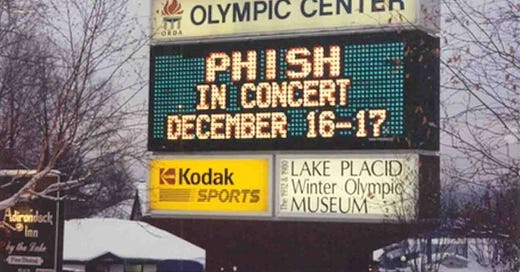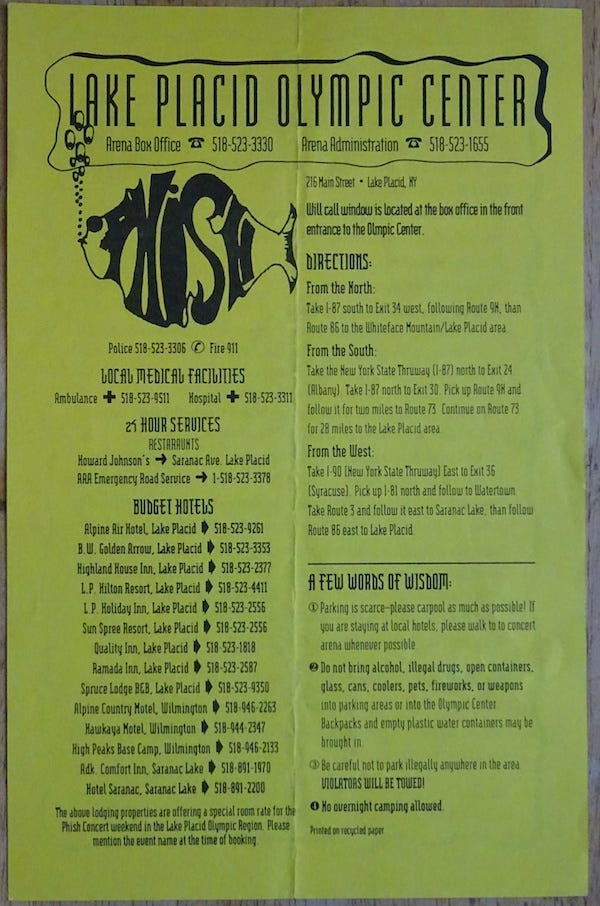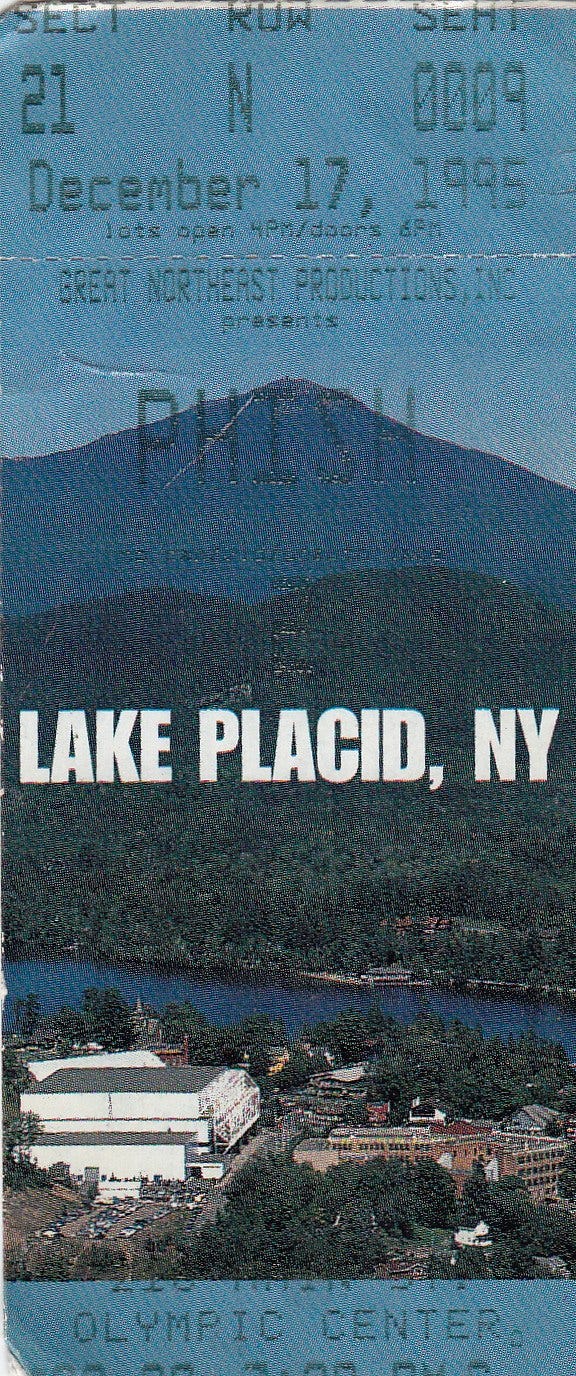SET 1: My Friend, My Friend > Poor Heart > A Day in the Life > Run Like an Antelope, The Mango Song > Tube > Stash, The Lizards, Chalk Dust Torture
SET 2: Bouncing Around the Room > Maze, Free > Also Sprach Zarathustra > Harry Hood > Sparkle > Tweezer -> Tweezer Reprise
ENCORE: Hello My Baby, Runaway Jim
Phish’s fall 1995 tour started in sunny Central California and ended, three months and 54 shows later, in snowy upstate New York. As with all the best Phish tours, the band that ended the tour barely resembles the quartet that started it, and not just because Trey got a rare haircut sometime in October. Many bands would use the nightly churn of a marathon tour as an excuse for falling back on routines, perfecting a setlist early on and refining it only marginally as the itinerary proceeds. But that’s not Phish — 54 shows means 54 opportunities for experimentation, evolution, and reinvention. If they didn’t come out different by the end, then what’s the point?
December 95 is widely considered the first Phish peak, the culmination of everything they’ve worked towards since getting drowned out by Thriller at the ROTC Dance in 1983. But that doesn’t mean that it wasn’t a work in progress as well, their successes accompanied by a restless desire to continue improving. There are a few themes I’ve picked at in these essays over the last three months, and the second night in Lake Placid, the last show for an entire 11 days, is a good time to fill out a report card of how those goals have developed since Sacramento.
Full Band Participation
Phish has never been comfortable being known as “Trey’s band,” and 1995 feels like the first year where they’ve really taken major evasive action against that identity. On stage, this resistance took the form of Trey’s new percussion kit, a secondary instrument that allows him to switch from melodic lead to rhythmic contributor at will. I came into the tour planning to defend against the somewhat-maligned mini-kit, but as it invaded more and more songs, I yielded to the same frustration many fans felt in 1995 — good intentions aside, why would one of the greatest guitarists avoid his chosen instrument, often in the middle of the night’s most exciting improvisational passages?
But you can’t argue with results. Maybe it wasn’t entirely the result of Trey’s instrument-switching, but Fall 95 definitely shows Page taking a leap forward in confidence, an increased willingness to step up and steer jams when the guitarist sits back. In this show, he’s practically the featured performer for the back half of set 1, taking his usual solos in Mango Song and Lizards but also leading the charge through Tube with a multi-board display as Trey picks up his sticks. He’s also still reliably providing counterpoint through excellent Stash and Hood jams, and bridges the gap between Tweezer and Tweeprise with a piano solo — the third show in a row where he’s given an extended spotlight after last night’s Coil and the Philly Gin pre-rotation.
And even though Trey’s percussion hobby intrudes upon Fishman’s turf, the drummer has perhaps the most important role in defining the Fall 95 sound, which I’ll return to in a moment. It’s only Mike who doesn’t seem to be fully comfortable yet stepping to the fore, with the caveat that it could just be the quieter position he occupies in the mix at this stage in Phish sonics. When the band hushes, as in the first few sparkling minutes of the 12/17 Hood, you can hear him in vivid conversation with Trey and Page. But it’s rare to find him altering the shape of a jam, particularly in contrast to the present day. In the effort to create a truly equitable four-man band democracy, there’s still work to be done; it will take nothing less than a full deconstruction of the band’s sound to achieve it.
Walls of Sound
A longer-term focus of the band — or at least Trey — dates back to early 94, when the guitarist starting messing with his trademark clean, compressed tone and raunching up his sound. I’m no pedal expert, but it certainly sounds like he’s added quite a few effects to his rig since that time: compare 1994 to 1996 at Trey’s Guitar Rig if you are someone who understands what the sequence of words “EHX Small Stone Phase Shifter” means. For myself, it all translates to “Phish sounding like they did in the late 90s,” an inexact description that definitely did not apply to 1993 and 1994 except in rare instances.
That changes in 1995, where Trey has not only leaned into heavier distortion (listen to the windmilling snarl on this show’s Tweezer jam, which again flirts with “25 to 6 to 4”) but also started using now-commonplace tools such as the wah pedal, the Leslie speaker, and the digital delay loop more often. It’s a secondary effect of the mini-kit; while Trey’s tip-tapping away, his feet are controlling looped washes of noise that add a new dimension to Phish’s jamming.
The others are also starting to get in on the act, with Page exploring his newish synthesizer (added in late 94, I believe) more often and Mike very infrequently using some delays as well. A telling moment was when Trey dropped into a Digital Delay Loop jam in Niagara Falls, and the rest of the band didn’t just drop out like they typically did in 94 versions, but reached into their own bag of effects tricks.
It all adds up to the progenitor of the Ambient Phish that will become increasingly important as they embrace their inner Eno, occasional flashes of the droney transitions and space-rock soundscapes that will spring from the cowfunk reinvention. The controversial “wall of sound” Hood ending from earlier in the tour may have disappeared, but similar approaches live on in the Bowie intro or stretches like the two minutes between Free and 2001 in this show, which sounds like it could have been lifted from The Siket Disc...an orbital drift that the tidy, clean sound of their olden days could never have produced.
Jukebox Heroes
They sound great on tape, but those full-band drones must have sounded even more immense in the types of rooms Phish was playing in Fall 95, through an arena-sized speaker system. And if there’s an unqualified success for this tour, it’s Phish expanding their sound to fill the basketball and hockey arenas that now fill the majority of their touring calendar. The Who, without even realizing it, played a crucial role of course, but it’s also the payoff of a band that has always tried to customize itself for its environment, the flip side of sharpening their unamplified bluegrass and a capella skills for acoustically-perfect theaters and opera houses.
The MVP of this embiggening effort is without question Jonathan Fishman, who has miraculously found a way to make his drumming much more powerful without sacrificing any of his complexity. That Arena Phish sound is built upon the skeleton of Fish’s bass and snare drums echoing off the high rafters, and many of the best moments come from friendly (mostly) arm wrestling between Trey and Fish, the New Haven Tweezer being the pinnacle of this ongoing battle.
Yet it’s very Phish that, simultaneous to perfecting this arena-rock sound, they’re also immediately trying to subvert it. It’s here that the rebuilding project remains incomplete; attempts such as Acoustic Army or the Rotation Jam to parody the excesses of a Big Loud Rock Concert end up tanking set momentum, and hijinks-laden shows like Hampton or Philly weren’t up to the standards of other nights down the stretch. They also seem to realize right away that it’s a creative dead end, because as much as they like and enjoy emulating The Who or Zeppelin or other Monsters of Rock, that’s not precisely their ultimate goal as musicians. Not to get ahead of myself, but the story of 1996 is partially how they work their way out of this discomfort, when the easy path would’ve been to just embrace it.
The challenge of what to do when you’ve reached the top has paralyzed many an artist, and it tripped up Phish at least twice in their career. But before we get into that, there are four more shows to play, including one of their greatest of all time. The first night in Lake Placid gave fans the stock version of Phish at their December 95 best, the second night provided both that display and exciting glimpses of the features they’d yet to fully unveil. Either way, they’ve earned a victory lap, and starting in eleven days, we’ll get it.
[Ticket stub from Golgi Project. Marquee photo posted by Kevin Shapiro.]





